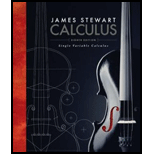
Single Variable Calculus
8th Edition
ISBN: 9781305266636
Author: James Stewart
Publisher: Cengage Learning
expand_more
expand_more
format_list_bulleted
Concept explainers
Question
Chapter A, Problem 42E
To determine
To find: The time interval when the ball is at least 32ft height.
Expert Solution & Answer
Want to see the full answer?
Check out a sample textbook solution
Students have asked these similar questions
A 20 foot ladder rests on level ground; its head (top) is against a vertical wall. The bottom of the ladder begins by being 12 feet from the wall but begins moving away at the rate of 0.1 feet per second. At what rate is the top of the ladder slipping down the wall? You may use a calculator.
Explain the focus and reasons for establishment of 12.4.1(root test) and 12.4.2(ratio test)
use Integration by Parts to derive 12.6.1
Chapter A Solutions
Single Variable Calculus
Ch. A - Rewrite the expression without using the...Ch. A - Rewrite the expression without using the...Ch. A - Rewrite the expression without using the...Ch. A - Prob. 4ECh. A - Rewrite the expression without using the...Ch. A - Prob. 6ECh. A - Prob. 7ECh. A - Rewrite the expression without using the...Ch. A - Prob. 9ECh. A - Rewrite the expression without using the...
Ch. A - Prob. 11ECh. A - Prob. 12ECh. A - Prob. 13ECh. A - Prob. 14ECh. A - Prob. 15ECh. A - Prob. 16ECh. A - Prob. 17ECh. A - Prob. 18ECh. A - Prob. 19ECh. A - Solve the inequality in terms of intervals and...Ch. A - Prob. 21ECh. A - Prob. 22ECh. A - Prob. 23ECh. A - Prob. 24ECh. A - Prob. 25ECh. A - Prob. 26ECh. A - Prob. 27ECh. A - Prob. 28ECh. A - Prob. 29ECh. A - Prob. 30ECh. A - Prob. 31ECh. A - Prob. 32ECh. A - Prob. 33ECh. A - Prob. 34ECh. A - Prob. 35ECh. A - Prob. 36ECh. A - Prob. 37ECh. A - Prob. 38ECh. A - Prob. 39ECh. A - Use the relationship between C and F given in...Ch. A - As dry air moves upward, it expands and in so...Ch. A - Prob. 42ECh. A - Prob. 43ECh. A - Prob. 44ECh. A - Prob. 45ECh. A - Prob. 46ECh. A - Prob. 47ECh. A - Prob. 48ECh. A - Prob. 49ECh. A - Prob. 50ECh. A - Prob. 51ECh. A - Prob. 52ECh. A - Prob. 53ECh. A - Prob. 54ECh. A - Prob. 55ECh. A - Solve the inequality. 56. 0x512Ch. A - Solve for x, assuming a, b, and c are positive...Ch. A - Prob. 58ECh. A - Solve for x, assuming a, b, and c are negative...Ch. A - Solve for x, assuming a, b, and c are negative...Ch. A - Prob. 61ECh. A - Prob. 62ECh. A - Prob. 63ECh. A - Use Rule 3 to prove Rule 5 of (2).Ch. A - Prob. 65ECh. A - Prob. 66ECh. A - Prob. 67ECh. A - Prob. 68ECh. A - Prob. 69ECh. A - (a) Is the sum of two irrational numbers always an...
Knowledge Booster
Learn more about
Need a deep-dive on the concept behind this application? Look no further. Learn more about this topic, calculus and related others by exploring similar questions and additional content below.Similar questions
- Explain the relationship between 12.3.6, (case A of 12.3.6) and 12.3.7arrow_forwardExplain the key points and reasons for the establishment of 12.3.2(integral Test)arrow_forwardUse 12.4.2 to determine whether the infinite series on the right side of equation 12.6.5, 12.6.6 and 12.6.7 converges for every real number x.arrow_forward
- use Corollary 12.6.2 and 12.6.3 to derive 12.6.4,12.6.5, 12.6.6 and 12.6.7arrow_forwardExplain the focus and reasons for establishment of 12.5.1(lim(n->infinite) and sigma of k=0 to n)arrow_forwardExplain the focus and reasons for establishment of 12.5.3 about alternating series. and explain the reason why (sigma k=1 to infinite)(-1)k+1/k = 1/1 - 1/2 + 1/3 - 1/4 + .... converges.arrow_forward
- Explain the key points and reasons for the establishment of 12.3.2(integral Test)arrow_forwardUse identity (1+x+x2+...+xn)*(1-x)=1-xn+1 to derive the result of 12.2.2. Please notice that identity doesn't work when x=1.arrow_forwardExplain the key points and reasons for the establishment of 11.3.2(integral Test)arrow_forward
arrow_back_ios
SEE MORE QUESTIONS
arrow_forward_ios
Recommended textbooks for you
 Glencoe Algebra 1, Student Edition, 9780079039897...AlgebraISBN:9780079039897Author:CarterPublisher:McGraw Hill
Glencoe Algebra 1, Student Edition, 9780079039897...AlgebraISBN:9780079039897Author:CarterPublisher:McGraw Hill Algebra: Structure And Method, Book 1AlgebraISBN:9780395977224Author:Richard G. Brown, Mary P. Dolciani, Robert H. Sorgenfrey, William L. ColePublisher:McDougal Littell
Algebra: Structure And Method, Book 1AlgebraISBN:9780395977224Author:Richard G. Brown, Mary P. Dolciani, Robert H. Sorgenfrey, William L. ColePublisher:McDougal Littell
 Functions and Change: A Modeling Approach to Coll...AlgebraISBN:9781337111348Author:Bruce Crauder, Benny Evans, Alan NoellPublisher:Cengage Learning
Functions and Change: A Modeling Approach to Coll...AlgebraISBN:9781337111348Author:Bruce Crauder, Benny Evans, Alan NoellPublisher:Cengage Learning College Algebra (MindTap Course List)AlgebraISBN:9781305652231Author:R. David Gustafson, Jeff HughesPublisher:Cengage Learning
College Algebra (MindTap Course List)AlgebraISBN:9781305652231Author:R. David Gustafson, Jeff HughesPublisher:Cengage Learning

Glencoe Algebra 1, Student Edition, 9780079039897...
Algebra
ISBN:9780079039897
Author:Carter
Publisher:McGraw Hill

Algebra: Structure And Method, Book 1
Algebra
ISBN:9780395977224
Author:Richard G. Brown, Mary P. Dolciani, Robert H. Sorgenfrey, William L. Cole
Publisher:McDougal Littell


Functions and Change: A Modeling Approach to Coll...
Algebra
ISBN:9781337111348
Author:Bruce Crauder, Benny Evans, Alan Noell
Publisher:Cengage Learning

College Algebra (MindTap Course List)
Algebra
ISBN:9781305652231
Author:R. David Gustafson, Jeff Hughes
Publisher:Cengage Learning

01 - What Is A Differential Equation in Calculus? Learn to Solve Ordinary Differential Equations.; Author: Math and Science;https://www.youtube.com/watch?v=K80YEHQpx9g;License: Standard YouTube License, CC-BY
Higher Order Differential Equation with constant coefficient (GATE) (Part 1) l GATE 2018; Author: GATE Lectures by Dishank;https://www.youtube.com/watch?v=ODxP7BbqAjA;License: Standard YouTube License, CC-BY
Solution of Differential Equations and Initial Value Problems; Author: Jefril Amboy;https://www.youtube.com/watch?v=Q68sk7XS-dc;License: Standard YouTube License, CC-BY